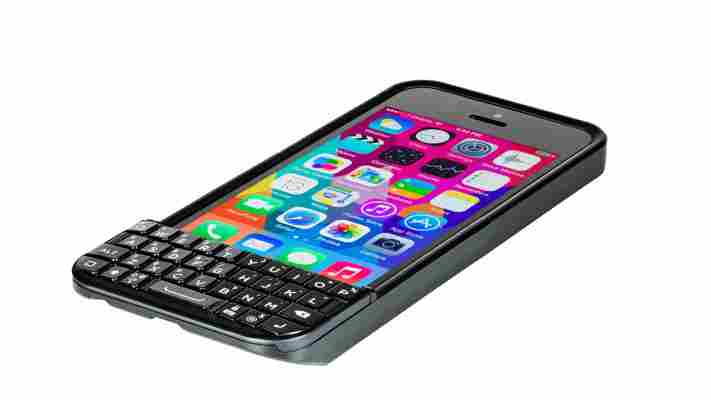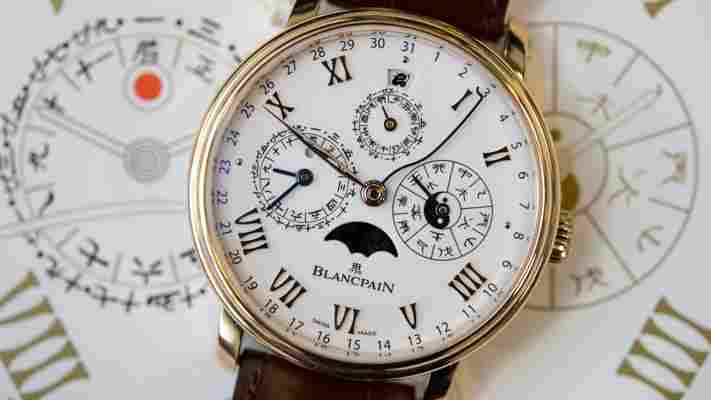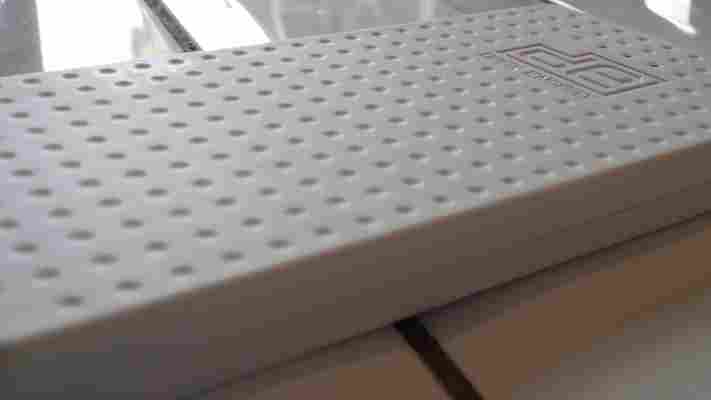The company behind the Typo keyboard case, which added a BlackBerry-style keyboard to your iPhone 5 or 5s, has announced the second version of the case , and this time it’s a tiny bit less like a BlackBerry.

While the original could perhaps make you a more productive note-taker or quicker at responding to messages, provided you didn’t mind what it did to the look of your carefully designed iPhone 5s, the company was taken to court for infringing on BlackBerry’s keyboard design. The result, as it stood in March this year, was a preliminary injunction putting a stop to sales.
With this second version, it will obviously be hoping to avoid going down the same road again – one of the changes which seems to have been made is removing the metal strips between each row on the keyboard. Nonetheless, it’d be hard to argue it looks nothing like a BlackBerry.
Of course, whether or not the market cares about Qwerty keyboards on phones anymore is a different question altogether.
If you do, you can pre-order one now for $99. Delivery starts in September.
It’s about time: September ticks over with another smartwatch explosion
As folks come back from their August vacations, September is poised for another rapid-fire batch of consumer electronics announcements. Samsung , Sony , Motorola and Apple all have major launches scheduled in the next couple weeks, not to mention the IFA show . New smartwatch products are expected at many of those events.

Last September was supposed to kick off the smartwatch revolution. In a single day, we saw Sony launch its Smartwatch 2 , Samsung release the Galaxy Gear , and Qualcomm announce the Toq . None of those have really taken off over the past year.
After being disappointed by the Galaxy Gear and the LG G Watch, my colleague Ben Woods has said he’s given up on smartwatches for now . It’s a natural sentiment given the current state of the space, but this year’s cohort should be a leap ahead of the previous generation. We’ll still be approaching new smartwatch announcements with skepticism, but there’s hope that this time’s the charm.
Up until now, new smartwatch products have lacked a true platform, leaving makers to improvise their own solutions. Google is trying to tackle the problem with the release of its Android Wear SDK. Meanwhile, Apple is laying the groundwork for a wearable platform with its HealthKit and HomeKit frameworks.
Among existing smartwatch companies, Pebble has made the most progress in building a platform for its developer community, but its product is a bridge device that offers limited functionality without being fully “smart.” The company is already serving a sizable market, but it’s still niche.
This year, the foundations for new platforms are in place. That doesn’t guarantee that successful smartwatch products will be built on top of them, but they certainly improves the odds.
Early smartwatch designs have been awkward. Many makers haven’t made the jump from designing electronics for your pockets to devices that you’re proud to wear on your wrist. The smartwatch space right now is a lot like the smartphone market in 2006. The Palm Treo and other Windows Mobile devices were technically “smart,” but they were clunky, hideous and unimaginative.
Motorola’s Moto 360 makes a fashion statement. We won’t all agree on whether it’s a positive one, but the important part is that it has takes a risk, instead of watering down design decisions until the product becomes utterly forgettable. You can bet that if Apple announces a watch too, it will also have a unique style.
We’re also excited about the design behind the Meta M1 watch , which is expected to start shipping in September. The company was spun off from Fossil, so it’s approaching smartwatches as an experienced watch maker, rather than a phone company.
Up until now, smartwatches have been stuck in an unfortunate compromise when it comes to features. Some do too little, some try to do too much. There’s a case to be made for both the well-thought-out minimalist watch that serves as a companion to your phone, and a powerful device with unique input, health features and contextual intelligence.
We still have yet to see a ‘killer app’ for watches. Notifications are certainly important, but buying a device and wearing it all the time just so you don’t have to take your phone out of your pocket is hardly a strong value proposition.
We’re eager to see the potential that tools like Google Now and Siri have when attached to our wrists. Motorola, for instance, is touting the Moto 360 as a watch that can keep you “on track, and on time.” Reliable voice assistants on your wrist could solve the cramped input issues that smartwatches have been plagued with. Sure, Samsung’s Gear watches have the S Voice feature, but it hasn’t lived up to its promise.
Health will also play a vital role in the success of smartwatches. The popularity of fitness bands have shown the interest that users have in collecting and monitoring their health data. The first watch that offers a meaningful positive effect on our health will sell by the millions. By playing a part in saving lives, it will be the literal opposite of a “killer” app, and we’re okay with that.
There’s still a lot we don’t know about the new smartwatch products coming next month. Recode , for instance, contends that Apple’s wearable won’t actually ship until 2015. Motorola offered controlled Moto 360 demos at Google I/O, but the specifics on many of its features remain fuzzy. Even so, if things go as planned, we’re on the cusp of watching a new product category mature, just like smartphones in 2007 and tablets in 2010.
I, for one, am hopeful about the devices we’ll see launched this September, but if smartwatches turn out to disappoint us yet again, electronics makers are at risk of coming across as The Boy Who Cried Wolf. Either way, it’s going to be an interesting month.
Top photo credit: FABRICE COFFRINI/AFP/Getty Images
Dark Energy Reservoir review: An 8,000mAh slimline battery pack for charging two devices at once
While modern smartphones, tablets and all kinds of other devices offer up a world of possibilities, they all require one thing – power.

They mostly share a common trait too, they’re generally not that power-efficient and can burn through a full charge in what seems like no time at all – this is certainly true for a lot of the power-hungry high-end smartphones you can buy today.
It’s no surprise then that there are a wealth of portable battery chargers (like the Satechi 10000 mAh or the Fluxmob ) on the market promising to keep your devices fully juiced when you’re away from mains power .
A recent entrant is the 8,000mAh Dark Energy Reservoir , which although packing slightly less of a punch than the Satechi, is lighter, thinner and better specced in other ways.
The first thing that struck me about the Dark Energy Reservoir is how thin it is; 11.9mm to be precise. It’s quite long too, at 139mm. Ultimately, it sort of looks and feels a bit like the size of a not-all-that-svelte smartphone – but don’t forget, it promises to recharge your phone four to five times before it needs recharging. Considering that, it’s remarkably thin and light.
The unit itself comes with a black or white, dimpled plastic case – we tested the white version.
On the front of the unit, there are three LEDs to indicate the charge level left in the Reservoir and on the right-hand side there’s a power button to start charging. Handily, when your phone or other devices are fully charged, the Reservoir stops trying to charge it so you won’t drain power there either.
On the bottom of the device are the two ports for connecting your devices. That’s right, ports. One is a 2.1A USB port for things like tablets and the other is a 1.0A port for your smartphone, both can be used simultaneously. Sitting between the two is a microUSB slot for charging up the Reservoir.
The company says that left untouched, the battery pack will hold its power for up to a year.
Touted as good for at least four full phone charges, my testing saw me get around that amount, although if you have particularly large capacity devices, it could be a little less. As well as using it just for charging my smartphone, I fully charged the Reservoir and then threw a few different devices at it.
From full, it happily took a totally dead YotaPhone , a nearly exhausted PlayStation Vita ‘Slim’ , and a pair of much-depleted Sol Republic Tracks Air wireless headphones back to 100 percent power. It even had a bit left over to recharge part of a Note 3 before giving up.
You might have noticed that up until now, I haven’t mentioned its price. It’s $129 (around £80) and if you want international delivery outside the US, that’s an additional $25 – making a total of $154 (~£95). So, it’s by no means the cheapest option on the market. Both the alternatives mentioned at the start of this article are considerably cheaper. There are other potential downsides too – as it has a pretty large capacity, it’ll need several hours solid charging to get it back to 100 percent if you do drain it all the way down.
Nonetheless, it’s small, relatively sleek and can really pack a punch, charging two devices simultaneously if you need to – and for that, it just about earns its price tag. As I said, it’s not the cheapest, but if what you want is four or five full charges of your phone ready to go at any time, you could do a lot worse than considering the Dark Energy Reservoir.
➤ Dark Energy Reservoir
